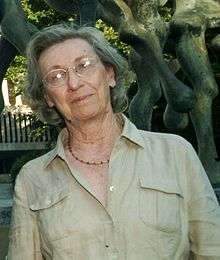Sandra Pizzarello
| Sandra Pizzarello | |
|---|---|
 | |
| Born |
1933 (age 83–84) Venice, Italy |
| Nationality | Italian |
| Alma mater | University of Padua |
| Occupation | Biochemist |
| Employer | Arizona State University |
| Website |
webapp4 |
Sandra Pizzarello, D.Bi.Sc. is an Italian biochemist known for her co-discovery of amino acid enantiomeric excess in carbonaceous chondrite meteorites. Her research interests concern the characterization of meteoritic organic compounds in elucidating the evolution of planetary homochirality. Pizzarello is a project collaborator and co-investigator for the NASA Astrobiology Institute (NAI), the president of the International Society for the Study of the Origin of Life, and an emerita professor at Arizona State University (ASU).
Early life and education
Sandra Pizzarello was born in Venice, Italy in 1933. In 1955, she graduated summa cum laude from the University of Padua earning her Doctor of Biological Sciences degree under her adviser Professor Roncato. Pizzarello went on to work as a research associate developing tranquilizers for Farmitalia Research Laboratories in the Department of Neuropharmacology. Over the course of several years, Pizzarello transitioned from research to raising a family. Following a career opportunity for her husband, an aeronautical engineer and computer scientist, she moved her family to Phoenix, Arizona in 1970.
Once Pizzarello's youngest of four children finished primary school, her focus returned to her career after a decade away from scientific research. She audited a graduate biochemistry seminar course at ASU where she met Professor John Cronin, future co-discoverer of amino acid enantiomeric excess in meteorites. Due to her outstanding performance in the course, she was offered a job to work with Cronin at the university as a research professor in analyzing the recently recovered Murchison meteorite.
Although a brilliant scientist, she is the only Italian mother who can't cook - fortunately for her children and herself, her husband is an excellent cook.
Research
Sandra Pizzarello's research over the last forty years has involved the analysis of organic compounds in several carbonaceous chondrites, particularly molecular, chiral, and isotopic characterization of amino acids. Because the formation of these organic-rich meteorites pre-date the origin of life, they had been under investigation as potential sites of primal organic compounds which could shed light on chemical evolution, specifically the origin of biological homochirality.[1] Such studies, however, had been inconclusive until 1997 when Cronin and Pizzarello detected 7-9% L-enantiomeric excesses of three abiological amino acids while analyzing the Murchison meteorite.[1]
Given Earth's history of meteoric impacts and the observation that meteors contain an excess of the biologically relevant L-stereoisomer of certain amino acids, Pizzarello studied the effect of meteoritic amino acids in enantiomeric excess on the formation of other biological molecules.[2] In one study, Pizzarello found that nonracemic solutions of abiological isovaline and proteinogenic alanine can direct the condensation of glycolaldehyde to produce nonracemic solutions of threose and erythrose via an aldol reaction concluding that amino acids can act as asymmetric catalysts in carbohydrate synthesis.[2] These findings support the origin of life hypothesis that homochirality originated prior to life and from extraterrestrial origins.[2] However, Pizzarello's theoretical inquiries into cosmochemical evolution remain debated based on suspect analytical evidence of meteoritic enantiomeric excesses.[3][4][5]
External links
- http://issol.org/
- https://nai.nasa.gov/directory/pizzarello-sandra/
- https://webapp4.asu.edu/directory/person/274781
References
- 1 2 Cronin, John R.; Pizzarello, Sandra (1997-02-14). "Enantiomeric Excesses in Meteoritic Amino Acids". Science. 275 (5302): 951–955. ISSN 0036-8075. PMID 9020072. doi:10.1126/science.275.5302.951.
- 1 2 3 Pizzarello, Sandra; Weber, Arthur L. (2004-02-20). "Prebiotic Amino Acids as Asymmetric Catalysts". Science. 303 (5661): 1151–1151. ISSN 0036-8075. PMID 14976304. doi:10.1126/science.1093057.
- ↑ Elsila, Jamie E.; Glavin, Daniel P.; Dworkin, Jason P.; Martins, Zita; Bada, Jeffrey L. (2012-11-27). "Inconclusive evidence for nonterrestrial isoleucine enantiomeric excesses in primitive meteorites". Proceedings of the National Academy of Sciences. 109 (48): E3288–E3288. ISSN 0027-8424. PMC 3511738
 . PMID 23064644. doi:10.1073/pnas.1213261109.
. PMID 23064644. doi:10.1073/pnas.1213261109. - ↑ Pizzarello, Sandra; Monroe, Adam A. (2012-11-27). "Reply to Elsila et al.: Large enantiomeric excesses in primitive meteorites, an analytical and computational supplement". Proceedings of the National Academy of Sciences. 109 (48): E3289–E3289. ISSN 0027-8424. PMC 3511719
 . doi:10.1073/pnas.1213714109.
. doi:10.1073/pnas.1213714109. - ↑ Pizzarello, Sandra; Schrader, Devin L.; Monroe, Adam A.; Lauretta, Dante S. (2012-07-24). "Large enantiomeric excesses in primitive meteorites and the diverse effects of water in cosmochemical evolution". Proceedings of the National Academy of Sciences. 109 (30): 11949–11954. ISSN 0027-8424. PMC 3409747
 . PMID 22778439. doi:10.1073/pnas.1204865109.
. PMID 22778439. doi:10.1073/pnas.1204865109.